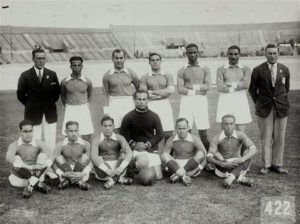
Football, or soccer as it’s known in some parts of the world, holds a unique place in Egyptian culture. As one of the most popular sports in the country, it has a long and storied history that intertwines with Egypt’s social, political, and cultural developments. From its early beginnings to the establishment of professional leagues, and the rise of legendary clubs, football in Egypt is not just a sport—it’s a way of life for millions.
Early Beginnings of Football in Egypt
The history of football in Egypt dates back to the late 19th century, a time when the country was under British occupation. British soldiers and expatriates introduced the game to Egypt, playing matches among themselves and with locals. The sport quickly gained popularity, particularly in the cities of Cairo and Alexandria, where the first organized matches took place.
The earliest recorded football match in Egypt occurred in 1882, just a few years after the British occupation began. This match, played between British military teams, marked the beginning of what would become a deep-rooted passion for football among Egyptians. As the sport grew in popularity, local Egyptians began to form their own teams, and football clubs started to emerge.
Formation of Football Clubs
The early 20th century saw the establishment of some of Egypt’s most iconic football clubs. These clubs were not only important for the development of football in the country but also played a significant role in the nationalistic movements of the time. Football became a symbol of resistance and unity against British colonial rule.
Al Ahly Sporting Club, founded in 1907, is perhaps the most famous and successful football club in Egypt. It was established by a group of Egyptian nationalists, led by Omar Lotfy, who envisioned the club as a place for young Egyptians to gather, train, and compete in sports, particularly football. Al Ahly quickly became more than just a football club; it was a symbol of Egyptian nationalism and a rallying point for the country’s independence movement.
Following the establishment of Al Ahly, other football clubs began to form across Egypt. Zamalek Sporting Club, originally known as Qasr El Nil Club, was founded in 1911. Like Al Ahly, Zamalek also played a significant role in the development of football in Egypt and quickly became one of the country’s top clubs. The rivalry between Al Ahly and Zamalek, often referred to as the “Cairo Derby,” would go on to become one of the most intense and famous football rivalries in the world.
In addition to Al Ahly and Zamalek, other clubs such as Ismaily SC (founded in 1924) and Al Ittihad Alexandria Club (founded in 1914) emerged during this period. These clubs helped to further popularize football in Egypt and laid the foundation for the establishment of a formal football league in the country.
The Birth of the Egyptian Football Association (EFA)
The growing popularity of football in Egypt led to the formation of the Egyptian Football Association (EFA) in 1921. The EFA was established to govern the sport, organize competitions, and represent Egypt in international football. It was one of the first football associations in Africa and the Middle East, and its creation marked a significant milestone in the history of Egyptian football.
One of the EFA’s first major achievements was the organization of the Egyptian Premier League, which officially began in 1948. The league brought together the top clubs from across the country to compete in a structured competition, providing a platform for the best Egyptian footballers to showcase their talents. Al Ahly, Zamalek, and Ismaily were among the inaugural teams in the league, and they quickly established themselves as the dominant forces in Egyptian football.
The EFA also played a key role in promoting football at the grassroots level. It established youth leagues and academies to nurture young talent and ensure the continued growth of the sport in the country. The association’s efforts paid off, as Egypt began to produce a steady stream of talented players who would go on to achieve success both domestically and internationally.
 Egypt’s Early International Football Success
Egypt’s Early International Football Success
Egypt’s early success in international football came in 1924 when the national team participated in the Olympic Games in Paris. This marked Egypt’s first appearance in an international football competition, and although they were eliminated in the first round, their participation signaled the country’s arrival on the global football stage.
Four years later, in 1928, Egypt returned to the Olympics, this time in Amsterdam. The Egyptian national team, known as the Pharaohs, made a significant impact by reaching the semi-finals, where they were narrowly defeated by Argentina. Egypt ultimately finished in fourth place, making them the first African team to reach the semi-finals of a major international football tournament.
The success of the 1928 Olympic team boosted the popularity of football in Egypt and further fueled the nation’s passion for the sport. It also highlighted the potential of Egyptian footballers to compete at the highest level, paving the way for future successes on the international stage.
The 1934 World Cup: Egypt Makes History
Egypt made history in 1934 by becoming the first African and Arab nation to participate in the FIFA World Cup. The tournament, held in Italy, was only the second edition of the World Cup, and Egypt’s qualification was a significant achievement for the country and the continent.
Egypt’s journey to the World Cup was not without its challenges. The team had to travel to Italy by sea, enduring a long and grueling journey that left them fatigued by the time they arrived. Despite these difficulties, the Egyptian team gave a commendable performance in their opening match against Hungary. Although they were defeated 4-2, Egypt’s participation in the 1934 World Cup was a historic moment that showcased the country’s footballing prowess on the global stage.
The 1934 World Cup also provided a platform for Egyptian players to gain international recognition. Mahmoud Mokhtar El-Tetsh, one of Egypt’s greatest footballers, was a standout player during the tournament. His performance against Hungary earned him praise from both Egyptian and international football circles, and he went on to become a legend in Egyptian football.
Post-World War II: The Golden Era of Egyptian Football
The period following World War II is often referred to as the “Golden Era” of Egyptian football. During this time, the Egyptian national team and club teams achieved significant success both domestically and internationally. The 1950s and 1960s were particularly fruitful for Egyptian football, as the country established itself as a dominant force in African football.
One of the most significant achievements during this period was Egypt’s victory in the inaugural African Cup of Nations (AFCON) in 1957. The tournament, held in Sudan, featured only three teams: Egypt, Sudan, and Ethiopia. Egypt emerged victorious, defeating Ethiopia 4-0 in the final to claim the first-ever AFCON title. Mahmoud El-Gohary, a key player in the Egyptian team, scored two goals in the final, further cementing his place as one of Egypt’s all-time greats.
Egypt’s success in the 1957 AFCON marked the beginning of a period of dominance in African football. The Pharaohs went on to win the AFCON again in 1959 and 1986, establishing themselves as the most successful team in the tournament’s early history. The 1986 victory was particularly special, as it was achieved on home soil in Cairo, with a thrilling penalty shootout win against Cameroon in the final.
The Rise of Egyptian Club Football
While the national team was achieving success on the international stage, Egyptian club football was also on the rise. The Egyptian Premier League, which had been established in 1948, became one of the strongest and most competitive leagues in Africa. Al Ahly and Zamalek continued to dominate the league, with their intense rivalry captivating football fans across the country.
Al Ahly, in particular, became a powerhouse in African club football. The club won its first African Cup of Champions Clubs (now known as the CAF Champions League) title in 1982, defeating Asante Kotoko of Ghana in the final. This victory marked the beginning of a period of dominance for Al Ahly in African football, as the club went on to win a record number of CAF Champions League titles.
Zamalek also enjoyed success in African club competitions, winning their first CAF Champions League title in 1984. The club’s success on the continental stage added to the intensity of the rivalry with Al Ahly, as both teams competed not only for domestic titles but also for supremacy in African football.
The success of Egyptian clubs in African competitions further elevated the status of football in Egypt. It also helped to raise the profile of Egyptian footballers, many of whom went on to have successful careers both in Egypt and abroad.
Challenges and Triumphs in Modern Egyptian Football
The turn of the 21st century brought new challenges and opportunities for Egyptian football. While the national team continued to enjoy success in the African Cup of Nations, winning the tournament in 1998, 2006, 2008, and 2010, the sport also faced significant challenges, including political instability and security concerns.
The 2011 Egyptian Revolution, which led to the ousting of President Hosni Mubarak, had a profound impact on football in the country. The political and social upheaval disrupted the domestic league, with the 2011-2012 season being canceled due to safety concerns following the Port Said Stadium disaster. The tragedy, which resulted in the deaths of 74 Al Ahly fans, was a dark chapter in Egyptian football history and led to widespread changes in the organization and security of football matches in the country.
Despite these challenges, Egyptian football showed remarkable resilience. The national team, under the leadership of coach Héctor Cúper, qualified for the 2018 FIFA World Cup in Russia, marking Egypt’s return to the tournament after a 28-year absence. The qualification was a momentous occasion for the country, and the team’s star player, Mohamed Salah, became a national hero.
Salah, who plays for Liverpool FC in the English Premier League, has become one of the most successful and recognizable Egyptian footballers of all time. His achievements on the international stage have brought global attention to Egyptian football and inspired a new generation of young players in the country.
The Role of Football in Egyptian Society
Football in Egypt is more than just a sport; it is an integral part of the country’s social fabric. The passion for the game transcends social, economic, and political divides, bringing together people from all walks of life. Football matches, particularly those involving the national team or the Cairo Derby between Al Ahly and Zamalek, are events of national significance, often drawing millions of viewers.
The sport also plays a role in addressing social issues in Egypt. Football academies and clubs provide opportunities for young people, particularly those from disadvantaged backgrounds, to develop their skills and pursue careers in the sport. In recent years, there have been efforts to use football as a tool for social change, with initiatives aimed at promoting education, health, and social cohesion through the sport.
Conclusion
The history of football in Egypt is a rich and complex tapestry that reflects the country’s broader social, political, and cultural developments. From its early beginnings under British occupation to its rise as a dominant force in African football, the sport has played a significant role in shaping Egypt’s national identity and bringing the country together in times of triumph and tragedy.
Egyptian football has produced some of the continent’s greatest players and teams, and its clubs have achieved success on the international stage. Despite the challenges it has faced, including political upheaval and security concerns, football in Egypt remains as popular and vibrant as ever.
As the country looks to the future, the continued growth and success of football in Egypt will depend on the ability to nurture young talent, invest in infrastructure, and address the social and political issues that impact the sport. With a rich history to build on and a passionate fan base to support it, Egyptian football is poised to continue its legacy as one of Africa’s most storied and celebrated footballing nations.

